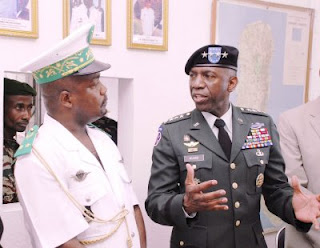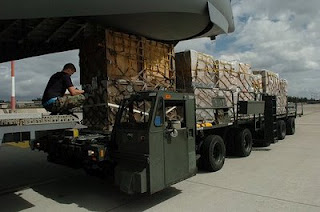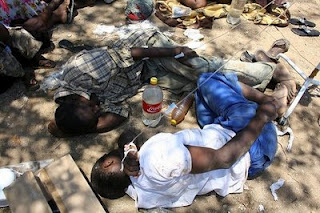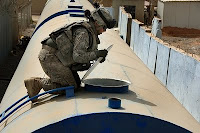-
Head of AFRICOM Discusses Civilian-Military Cooperation
›January 28, 2009 // By Rachel Weisshaar Critics have warned that the new unified U.S. Africa Command (AFRICOM) could threaten the sovereignty of African nations and encroach on the portfolios of other U.S. agencies like the U.S. Agency for International Development (USAID). But in an interview with USAID newsletter FrontLines, General William E. “Kip” Ward, head of AFRICOM, went out of his way to dispel these fears. Some of the most interesting parts of the interview:
Critics have warned that the new unified U.S. Africa Command (AFRICOM) could threaten the sovereignty of African nations and encroach on the portfolios of other U.S. agencies like the U.S. Agency for International Development (USAID). But in an interview with USAID newsletter FrontLines, General William E. “Kip” Ward, head of AFRICOM, went out of his way to dispel these fears. Some of the most interesting parts of the interview:
On AFRICOM’s humanitarian efforts:
“We know that our piece is only a very small part of the totality of humanitarian assistance that’s being performed by USAID and other agencies. We would not look to take those roles over.”
On civilian-military cooperation:
“We are learning to understand one another better and truly, as [USAID] Administrator [Henrietta] Fore and [Defense] Secretary [Robert] Gates said, we are seeing with greater clarity the importance of all these efforts working as cohesively together as they can. Security and development go hand-in-hand to produce stability that we all seek.”
On coordinating with USAID and host countries:
“We would get involved where those development projects complemented the work being done by developmental agencies, USAID, in very close coordination with the country team, the ambassador, and representatives from USAID that are there on the ground. We want to ensure that we don’t do things that conflict with the work being done by others. This might include a school being built so we can complement each other’s efforts. Or, at the request of a country, we might conduct an exercise and we may need to build a road to get to a training area. And if building the road in one place or another could help the population, then we would look to work with the country team and the ambassador so it provides benefits to the population.”
Photo: Comoran Defense Chief of Staff Salimou Mohamed Amiri (left) talks with General William E. Ward, commander of U.S. Africa Command (right), on January 21, 2009. Ward met with Comoran government officials as part of his first official visit to the island nation. Courtesy of by Kenneth Fidler, U.S. Africa Command. -
Population, Family Planning Experts Urge Obama to Make Billion-Plus Investment
›January 22, 2009 // By Rachel WeisshaarFamily planning experts and advocates have wasted no time urging President Barack Obama to reverse former President George W. Bush’s international family planning policies. Five former directors of population and reproductive health at the U.S. Agency for International Development (USAID) call for the United States to renew its political and financial commitment to global family planning programs in Making the Case for U.S. International Family Planning Assistance, a report by the Population Reference Bureau (PRB). The former bureaucrats recommend that USAID’s budget for international family planning be increased to $1.2 billion in FY 2010, up from $457 million in FY 2008, and that it be raised gradually to $1.5 billion in FY 2014 in order to achieve the Millennium Development Goal of universal access to reproductive health services by 2015.
In a compelling white paper (executive summary) submitted to the Obama transition team by Population Action International (PAI), the authors argue that by investing in voluntary family planning, the United States can “foster more peaceful, stable societies and improve maternal and child health, reduce unintended pregnancies and abortion, lower HIV infection rates, reduce poverty, enhance girls’ education, decrease hunger, and slow the depletion of natural resources.” PAI asks President Obama to:- Increase total U.S. FY 2010 spending on family planning and reproductive health to $1 billion;
- Rescind the Global Gag Rule/Mexico City Policy;
- Restore U.S. funding to the UN Population Fund; and
- Increase funding for programs to reduce maternal and child mortality, prevent the spread of sexually transmitted diseases, and improve the status of women.
-
The Air Force’s Softer Side: Airpower, Counterterrorism, and Human Security
›January 15, 2009 // By Rachel Weisshaar“The countries in which terrorism could gain a foothold contain vast areas that are poverty-stricken and lawless. The common denominator within these areas is the absence of human security for the local population,” argues Major John Bellflower in “The Soft Side of Airpower” in the Small Wars Journal. “[A]dopting a human security paradigm as a counterinsurgency strategy could generate positive effects in the war on terror, particularly within AFRICOM,” and the Air Force could play a significant role in bringing human security to vulnerable populations, he claims.
When we picture the Air Force as an instrument of soft power, we tend to think of planes airlifting humanitarian aid into impoverished or disaster-stricken areas. But Bellflower argues that the Air Force could also help fulfill the longer-term health, food, economic, environmental, and community aspects of human security. For instance, the Air Force currently provides short-term health care in Africa through MEDFLAG, a biannual medical exercise. Bellflower suggests MEDFLAG “could be expanded to include a larger, centrally located field hospital unit that could serve a number of dispersed clinics.”
Bellflower also advocates deploying the Air Force’s Rapid Engineer Deployable Heavy Operational Repair Squadron Engineers (REDHORSE) into impoverished, unstable areas to build airstrips, drill wells, and employ local labor to construct “clinics, schools, police stations, community centers, or whatever is needed for a particular area. Additionally, these units could repair existing facilities to allow electricity, water, and other needed life support systems to become functional or construct earthen dams or the like to protect against natural disaster and meet environmental security needs.” Employing young men to build this infrastructure “results in a lower chance of these individuals succumbing to the lure of terrorist group recruiting tactics,” asserts Bellflower.
Bellflower joins a growing cadre of academics and practitioners arguing that the Department of Defense (DoD) should be more involved in peacebuilding and international development. He makes an original contribution in detailing how the Air Force—typically viewed as the most hands-off branch of the armed forces—could help stabilize poor, volatile regions. Yet his vision would likely attract objections from both sides. Many humanitarian aid groups would resist what they view as DoD’s repeated incursions into an area in which it lacks expertise and has ulterior (i.e., national security) motives. On the other side, many military personnel would view this as an example of mission creep, and would hesitate to send soldiers into risky areas simply for humanitarian reasons.
Photo: A U.S. Air Force Europe airman from the 793rd Air Mobility Squadron moves humanitarian supplies into position for loading in support of the humanitarian mission to Georgia in August 2008. Photo courtesy of Captain Bryan Woods, 21st TSC Public Affairs, and Flickr user heraldpost. -
Could Threat of Regional Cholera Pandemic Finally Topple Zimbabwe’s Mugabe?
›December 23, 2008 // By Rachel Weisshaar
Zimbabwe’s current cholera epidemic has killed more than 1,100 people and sickened nearly 24,000, prompting the United States, the United Kingdom, and some African nations to press for sanctions on—and the resignation of—President Robert Mugabe. The impoverished country ranks 151 out of 177 on the UN Human Development Index and has an average life expectancy of 34 for women and 37 for men. Although it has suffered yearly cholera outbreaks since 1998, this year’s epidemic dwarfs previous ones. The epidemic is being aggravated by severe food shortages and the country’s high prevalence of HIV/AIDS, and is expected to continue through the end of the rainy season in March.
-
Greening the U.S. Army: Report Calls Environment Critical to Post-Conflict Operations
›December 11, 2008 // By Rachel WeisshaarGreen Warriors: Army Environmental Considerations for Contingency Operations from Planning Through Post-Conflict (summary) is a comprehensive new RAND report on the U.S. Army’s environmental record in combat and peacekeeping operations. Green Warriors, which was commissioned by the Army Environmental Policy Institute, gives four main reasons why the Army should care about its environmental impacts, particularly in light of its lengthening overseas engagements:
- The environment can threaten soldiers’ health (through disease, polluted air or water, or exposure to hazardous substances);
- The military can harm its credibility with local populations by improperly disposing of waste or by damaging farmland or water supplies;
- Reconstruction projects that improve environmental conditions can foster support for the United States and the host-country government it supports, improving economic growth and security; and
- Environmental problems are often transboundary, and it is important to avoid allowing deficient U.S. environmental practices strain our relationships with other countries, especially given their importance to U.S. military activities.
Green Warriors emphasizes that environmental considerations are particularly significant during the post-conflict phase of operations:
[L]ocals often care deeply about the environment, which can be critical to their survival, livelihood, and well-being. Vital environmental issues can include access to clean drinking water, effective sewage systems, and viable farmland (see Box 1.1). Restoring or building these basic infrastructures is often essential for the economic and social development necessary for stability. To the extent that such projects improve cooperation with locals, they can lower security risks, improve intelligence, and speed reconstruction.
According to Green Warriors, the Army possesses extensive environmental policies and regulations for domestic and permanent foreign installations. Yet there are extremely few environmental regulations for contingency operations. The authors make the following recommendations:
- Improve environmental policy and guidance. The Army Strategy for the Environment, the Army’s new field manual on stability and reconstruction operations (New Security Beat coverage), and DoD’s 2005 decision to elevate post-conflict operations to the same level as combat operations (DoD Directive 3000.05) all provide a foundation upon which to build a standard DoD-wide environmental policy.
- Promote an environmental ethic and culture that extends to contingency operations. The Army must encourage soldiers and commanders to recognize and embrace the strategic benefits of good environmental stewardship.
- Incorporate environmental issues more extensively into planning. Commanders should receive high-quality environmental information and analysis, and risk assessments should be routinely undertaken.
- Improve environmental training and awareness. Commanders, soldiers, and non-combatant personnel should receive training on environmental issues both prior to and during their deployment. This training should include lessons learned from field experience.
- Expand environment-related investment. The Army should invest in personnel with the skills to implement a global environmental program and expand research and development to create technologies that would minimize environmental impacts of Army’s operations.
- Use the concept of sustainability as a guiding principle. The Army Strategy for the Environment calls sustainability the “keystone” of the Army’s environmental strategy, and the RAND report encourages the Army to expand this principle into all aspects of its contingency operations.
In a memo released with the report, Addison Davis IV, deputy assistant secretary of the Army for environment, safety, and occupational health, says that “the Army has the power to implement most” of the report’s recommendations. The question remains: Is the Army’s leadership willing to do so?
Photo: U.S. Army Spc. Gabriela Campuzano, a water purification specialist with the 94th Brigade Support Battalion, 4th Brigade Combat Team, 10th Mountain Division, inspects one of three water storage tanks at a water purification project site at the Baghdad Al Jadeeda Police Station in Baghdad, Iraq, June 12, 2008. The water site provides the local community with clean drinking water. Courtesy of Staff Sgt. Brian D. Lehnhardt, the U.S. Army, and Flickr. -
Sustaining the Environment After Crisis and Conflict
›December 4, 2008 // By Rachel Weisshaar “Unfortunately, disasters are a growth industry,” said Anita Van Breda of the World Wildlife Fund (WWF) at “Sustaining Natural Resources and Environmental Integrity During Response to Crisis and Conflict,” a November 12 meeting sponsored by the Wilson Center’s Environmental Change and Security Program. But the impact of increased disasters on the environment is not a priority for first responders: According to Charles Kelly, an affiliate of the Benfield Hazard Research Centre at University College London, their perspective is, “How many lives is it going to save, and how much time is it going to take?” Environmentalists, who tend to think in terms of decades and generations, can find it difficult to communicate effectively with aid workers. “You give a 30-page report and it’s not going to be read, and there’s going to be no action,” said Kelly.
“Unfortunately, disasters are a growth industry,” said Anita Van Breda of the World Wildlife Fund (WWF) at “Sustaining Natural Resources and Environmental Integrity During Response to Crisis and Conflict,” a November 12 meeting sponsored by the Wilson Center’s Environmental Change and Security Program. But the impact of increased disasters on the environment is not a priority for first responders: According to Charles Kelly, an affiliate of the Benfield Hazard Research Centre at University College London, their perspective is, “How many lives is it going to save, and how much time is it going to take?” Environmentalists, who tend to think in terms of decades and generations, can find it difficult to communicate effectively with aid workers. “You give a 30-page report and it’s not going to be read, and there’s going to be no action,” said Kelly. -
Can Haiti Change Course Before the Next Storm?
›November 14, 2008 // By Will Rogers Though the floodwaters have finally receded, Gonaives—Haiti’s third-largest city—remains buried in 2.5 million cubic meters of mud, one in a long list of miseries plaguing those desperate for relief. Four major storms have ravaged Haiti since August, and recovery and reconstruction are projected to span several years and cost upwards of $400 million. While the international community has committed $145 million in disaster relief—nearly $32 million from the United States alone—the price tag for long-term development assistance could well exceed these early estimates as the extent of the damage becomes clearer. But reconstruction efforts could be moot if Haiti fails to adopt environmentally sustainable development practices.
Though the floodwaters have finally receded, Gonaives—Haiti’s third-largest city—remains buried in 2.5 million cubic meters of mud, one in a long list of miseries plaguing those desperate for relief. Four major storms have ravaged Haiti since August, and recovery and reconstruction are projected to span several years and cost upwards of $400 million. While the international community has committed $145 million in disaster relief—nearly $32 million from the United States alone—the price tag for long-term development assistance could well exceed these early estimates as the extent of the damage becomes clearer. But reconstruction efforts could be moot if Haiti fails to adopt environmentally sustainable development practices. -
Weekly Reading
›Military leaders and climate experts gathered in Paris for a November 3-5 conference on the role of the military in combating climate change. A conference report will include “proven strategies to reduce greenhouse gas emissions while improving military effectiveness.”
The 2008 Africa Population Data Sheet, a joint project of the Population Reference Bureau and the African Population and Health Research Center, reveals significant differences between northern and sub-Saharan Africa. Also from PRB, “Reproductive Health in Sub-Saharan Africa” examines family planning use, family size, maternal mortality, and HIV/AIDS in major subregions of sub-Saharan Africa.
In the October 2008 issue of Humanitarian Exchange Magazine, Alexander Tyler of the Office of the UN High Commissioner for Refugees for Somalia argues that longer-term livelihoods projects must be incorporated into emergency humanitarian relief efforts. The authors of the Center for American Progress report The Cost of Reaction: The Long-Term Costs of Short-Term Cures (reviewed on the New Security Beat) would likely agree; they argue that although emergency aid is necessary, “what is true in our own lives is true on the international stage—an ounce of prevention is worth a pound of cure.”
The Dining & Wine section of the New York Times profiles a Quichua community in the Ecuadorian Amazon that has formed a successful chocolate cooperative with the help of a volunteer for a biodiversity foundation. “They wanted to find a way to survive and thrive as they faced pressure from companies that sought to log their hardwood trees, drill on their land for oil and mine for gold,” reports the Times.
Showing posts from category humanitarian.


 Critics have warned that the new unified U.S. Africa Command (
Critics have warned that the new unified U.S. Africa Command (


 “Unfortunately, disasters are a growth industry,” said Anita Van Breda of the World Wildlife Fund (WWF) at “
“Unfortunately, disasters are a growth industry,” said Anita Van Breda of the World Wildlife Fund (WWF) at “ Though the floodwaters have finally receded, Gonaives—Haiti’s third-largest city—remains buried in
Though the floodwaters have finally receded, Gonaives—Haiti’s third-largest city—remains buried in 

